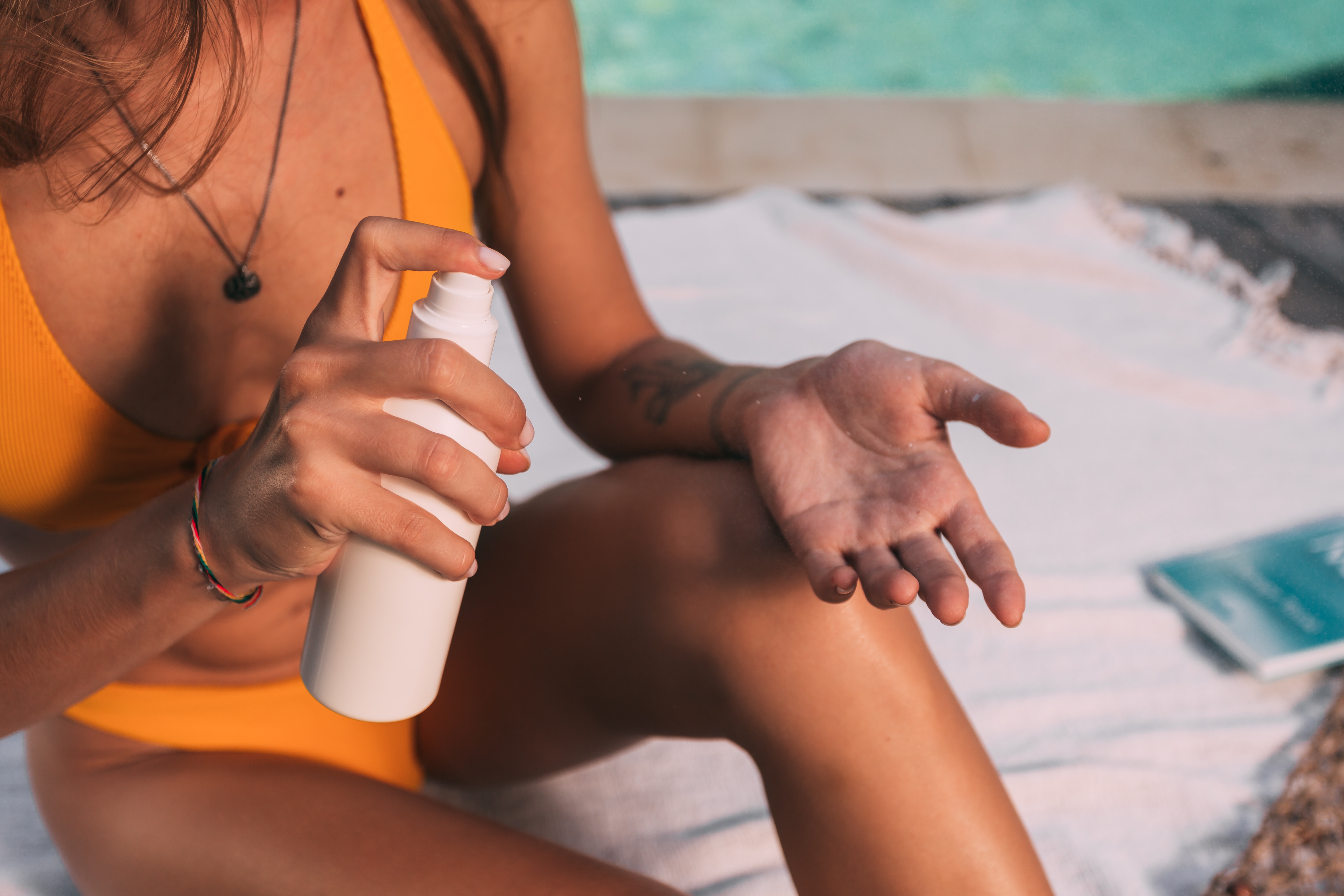The use of sunscreen as we know it today dates back to the beginning of the 20th century, correlated with the arrival of paid vacations in France. But some mentions of protective products even date back to the period of Ancient Egypt. The sun’s radiation has always had an impact on human beings. An impact sometimes visible, as the famous sunburns, or sometimes invisible, as it is the case of ultraviolet radiation.
Ultraviolet radiation (UV) is an electromagnetic radiation with a wavelength shorter than that of visible light; it cannot therefore be observed by the naked eye. This radiation is emitted by the Sun and represents about 5% of the solar electromagnetic energy. UV radiation can be classified into three categories according to their wavelength (UVA, UVB and UVC). Due to the presence of the ozone layer and the atmosphere, 95% of the UV reaching the Earth’s surface is UVA.
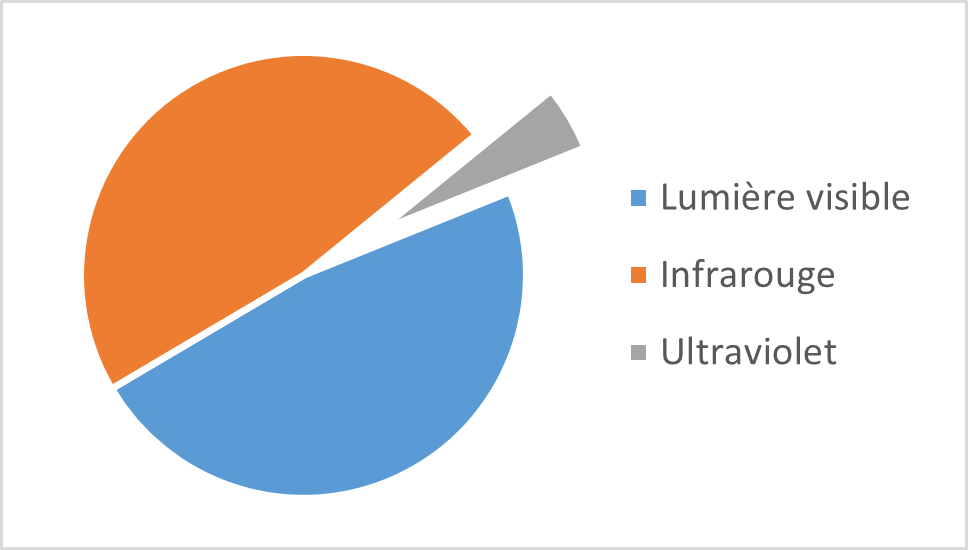
UV rays pass through the atmosphere in all weather conditions, even cloudy ones. They are independent of the sensation of heat in the sun which is caused by infrared. Note that UV is reflected by water, sand, and especially snow. In addition, the presence of a hole in the ozone layer increases the amount of UV that reaches the surface of the Earth.
In small quantities, UV rays are very useful. It allows the synthesis of vitamin D, an essential vitamin for the mineralization of bones and joints, as well as for muscle tone. It also helps to avoid rickets.
UV rays are also responsible for tanning. Indeed, under the action of radiation, cells of the epidermis (the keratinocytes) will multiply to allow an increased resistance of the cutaneous barrier. At the same time, other skin cells, the melanocytes, will be stimulated to create melanin, a colored substance with the property of absorbing UVB rays and thus protecting the skin.
But at high doses, and especially in some people with lighter skin, UV is harmful. UVA rays are able to penetrate the deep layers of the skin (the dermis). They are responsible for premature aging and the appearance of wrinkles, but also for the production of free radicals within the cells. UVA rays are also dangerous for children’s eyes, as the lens does not yet act as a filter.
UVB rays are absorbed more by the surface layer of the epidermis. They are capable of producing large quantities of oxygenated free radicals and are responsible for sunburn and skin inflammation. They are also much more carcinogenic than UVA (UVB is implicated in 65% of skin cancers against 35% for UVA). They are also more harmful to the eyes.
In France, nearly 80,000 skin cancers are diagnosed each year. Among them, we find a little more than 10% of melanomas, which are the most serious cancers and whose incidence has more than tripled between 1980 and 2005. Almost 70% of these melanomas are due to sun exposure.
UVCs are harmful, but they are totally filtered by the ozone layer and do not reach the Earth’s surface.
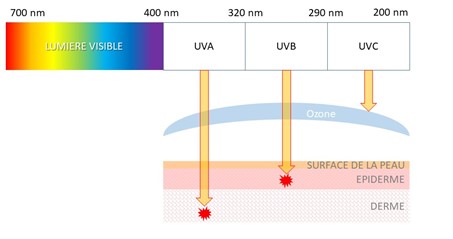
Sunscreens were therefore created with the aim of protecting its consumers from radiation and today represent a market of around 172.5 million euros in 2017.
For the average consumer, a sunscreen product is a cream or lotion used to reduce the skin’s exposure to the sun’s ultraviolet radiation. It is a means of passive external photo protection, working as an ultraviolet filter. There are many types of sunscreen products on the market, as well as day creams, foundations, lip sticks and hair products that contain UV filters.
For a specialist, a sun product is generally in the form of an emulsion that contains the following species
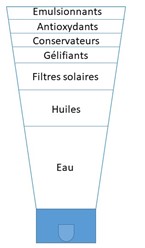
These are the solar filters that will reduce exposure to ultraviolet radiation. There are two categories:
- Organic (or chemical) filters, which are made up of organic molecules that react with UV rays and absorb the radiation instead of the skin. Laboratories are obliged to choose filters from a list of products authorized by the health authorities. It should be noted that organic filters are only effective 20 to 30 minutes after application.
- Mineral filters reflect UV rays like microscopic mirrors. They are made up of micro-pigments: titanium dioxide or zinc oxide. These filters are effective as soon as they are applied.
Creams can contain either organic or mineral filters; some sunscreens contain both types of filters.
These are the materials on which the whole controversy of sunscreens is based. Our bodies or even the marine environment are regularly confronted with these molecules, not without the slightest impact.
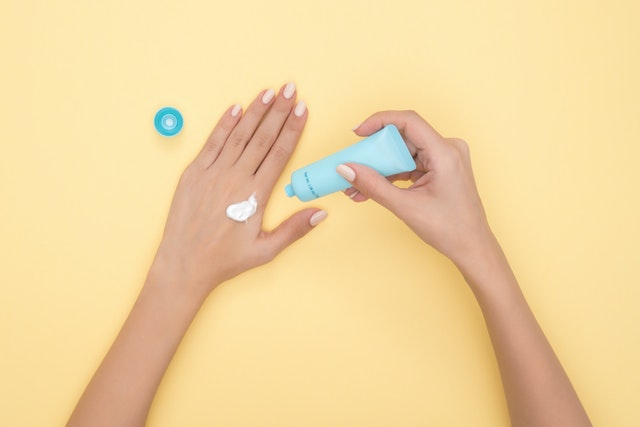
Overexposure to the sun
The use of sunscreens protects against UVB and also starts to filter UVA. But they have a perverse effect: people who use sunscreens believe they are protected from the sun and tend to expose themselves longer to the sun. The application of a product with a sufficient protection factor is recommended in case of unavoidable sun exposure. The application should be done before exposure and renewed regularly if exposure persists.
This type of product is to be used in addition to other existing methods. Such as: wearing clothes, sunglasses and a hat, not being exposed to the sun between 12 noon and 4 p.m. in France in the summer (because UVB radiation is at its highest intensity) and limiting the duration of exposure.
Chemical filters that are harmful to our hormones
Our skin is not an impenetrable barrier. Once the sunscreen is applied, the filters penetrate our body and end up in our blood. Some of them have even been detected in breast milk! These are the conclusions of a Swiss study conducted on 52 women from the maternity hospital in Basel. The participants were asked about their use of cosmetic products through a questionnaire. The milk samples were then analyzed for a wide range of chemicals, including UV filters. The researchers found traces of UV filters in 85% of the breast milk samples! They also found that there was a link between the application of sunscreens during pregnancy and the presence of two chemical compounds: 4-Methylbenzylidene camphor (4-MBC) and octocrylene (OC).
Once introduced into the body, these chemical filters can affect human health, but also animal health. One study looked at the potential endocrine disrupting effects of sunscreens. Among the 9 filters studied, 8 mimicked the effect of estrogen; 2 showed antiandrogenic properties, i.e. they are likely to be feminizing. Finally, 6 caused an increase in the weight of the uterus of female rats. The study also showed that exposure of animals to certain filters before and after birth affected hormonal development and modified the expression of genes regulated by female hormones. Congenital malformations, delayed puberty in males and changes in reproductive organs were observed. According to the study, exposure to these UV filters during pregnancy could pose the same risk to fetuses.
Mineral filters wih nanoparticles
Given the danger of these chemical filters, it is often recommended to use sunscreens containing only mineral filters. These are generally titanium dioxides and zinc oxides. Mineral filters (in so-called “organic” creams) are hypoallergenic and photostable (which makes them the recommended sun product for allergic subjects and children). They are also effective as soon as they are applied. However, they are less appreciated by vacationers because they are more difficult to spread and give users an unattractive whitish tint. To improve the cosmetic aspect, laboratories have formulated products with filters in the form of nanoparticles. The small size of these materials allows sunscreens to have a better fluidity and a good hold.
But nanoparticles can also present health risks. In 2006, a study showed that their passage through the cells of the body and then to the bloodstream and internal organs is facilitated by their small size. Also, it has been suggested that titanium dioxide can induce DNA damage, thus promoting the development of cancer.
In addition, titanium oxide particles are less effective than zinc particles at UVA level. They react to light (photo degradation) by creating free radicals. But this phenomenon can be reduced by adding zinc oxide, which is why it is widely used.
Despite what the sellers may specify “without nano particles”, we will find zinc or titanium in this form, because zinc oxides are 30 to 200 nm, and 10 to 100nm for titanium.
Finally, the use of nanoparticles in spray or powder formulas exposes nanoparticles to inhalation, which can penetrate very deeply into the respiratory system and pass into the blood via the pulmonary alveoli. Apart from this particular situation, it has not yet been possible to reach a definitive conclusion on the danger of nanoparticles. The French National Agency for the Safety of Medicines (ANSM) nevertheless recommends not to use cosmetics – in particular sun creams – containing titanium dioxide nanoparticles on injured skin or on sunburns because of the potential risks for human health.
The effects of sunscreens do not only concern our body. For some years now, the chemical filters used in sun creams have been accused of causing significant water pollution. The filters can indeed be found in the water directly when swimming, or via the wastewater treatment plants when the filters are evacuated during showers, baths or laundry.
The effects of sunscreens on corals
Among the effects of sunscreens on the environment, it has been shown a critical effect on corals. It was in 2008 that the first study. This study, conducted in several tropical regions, showed that extremely low concentrations of sunscreens caused viral infections on microalgae located in the corals and functioning in symbiosis with them. These infections were responsible for coral bleaching and death within 48 hours. In 2015, a study conducted in Hawaii and the Virgin Islands implicated a sunscreen, oxybenzone, which can cause significant deformities in coral larvae and death.
It is estimated that 4,000 to 6,000 tons of sunscreen are released each year in tropical reef areas by the 78 million tourists who visit them. Thus, 10% of the world’s coral reefs would be threatened by sunscreens! The consequences are serious because corals represent a habitat for many marine species, but they are also a precious food resource for the neighboring populations; finally, they protect the coasts by forming a very effective barrier against the elements of the open sea.
The consequences on marine animals
Corals are not the only species threatened by the components of sunscreen products. One study has also suggested significant effects on certain planktonic species. One study showed that some sunscreens released into the water promote the appearance of hydrogen peroxide (hydrogen peroxide, H2O2), a powerful oxidant that can affect the growth and development of plankton. It has also been shown that organic sunscreens accumulate in marine filter feeders such as mussels.
After all its controversies, a first ban on the marketing of sunscreen products was voted in Hawaii in May 2018. This measure will concern all products containing the following organic filters: oxybenzone and octinoxate. They will only be provided in case of exceptional medical prescription. This new law will come into force in the summer of 2021.
In the European Union, this type of law has not yet been addressed, but a first step was taken in 2006 in favor of consumers. The project aimed to guarantee equal or superior protection to UVA compared to UVB. Thus, as we have seen above, the consumer is protected from the most harmful radiation.
The impact of sunscreen products on consumers and on the environment is no longer to be demonstrated. However, the legislation does not seem to want to change the habits of consumers. Today, as a chemist, formulator and manufacturer, PolymerExpert offers a solution to reduce the impact of sunscreen products.
A few years ago, PolymerExpert developed ExpertGel®. This water-soluble polymer is an innovative gelling agent; its viscosity increases with temperature. In solution in water, the product behaves like a liquid and then becomes a thick gel when the temperature increases. The gelling temperature is easily adjustable.
This property is due to the nature of the polymer. It is poloxamer, a hyperbranched copolymer composed of (B) PEO/PPO/PEO blocks linked by organic bonds of urethane and/or urea type (U).

The formation of the gel is explained by the self-association of the hydrophobic portions (PPO) into micro-domains from the LCST (Lower Critical Solubility Temperature) onwards, with the whole polymer being held in solution by the hydrophilic segments (PEO). With this configuration, the viscosity of an ExpertGel solution becomes more important above a certain temperature.
PolymerExpert has chosen to integrate this polymer in several sunscreen formulations. The resulting properties have been of real benefit to both the consumer and the environment. Moreover, unlike other poloxamers available on the market, ExpertGel reveals its properties from 1% in formulation.
Increase of the solar protection (SPF)
In suncare products, the addition of ExpertGel brings many properties. During the application, the passage of the ambient temperature to the body temperature, allows the rise in viscosity of the product. The solar filters, or all other charges besides, are better distributed and the gelled matrix imprisons the filters. It thus avoids the penetration of the organic filters inside the skin. These combined actions guarantee a uniformity of the solar filters on the surface of the skin and thus a better protection.
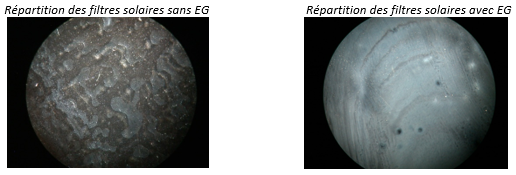
It has been shown that the sun protection factor can be doubled, even tripled for certain formulations.
| Type of product | SPF without EG | SPF with EG |
| Spray | 22 ± 2 | 60 ± 4 |
| Lotion | 24 ± 3 | 42 ± 4 |
| Lotion | 32 ± 2 | 58 ± 3 |
| Cream | 25 ± 4 | 32 ± 3 |
| Spray | 19 ± 3 | 33 ± 4 |
| Spray | 19 ± 3 | 33 ± 4 |
This property of booster of SPF, allows :
- to protect the consumer to a greater extent
- to reduce the costs of the formulation for the manufacturer
- to reduce the amount of sunscreens released in the oceans.
Water resistence
According to the patent filed by Edgewell Personal care (WO2016/138249), the ExpertGel® acts in synergy with film formers to increase the water resistance of sunscreen products.
Samples 2,11 and 12 contain 1.25% ExpertGel®.
The ExpertGel provides a long-lasting effect of the sun protection product, as well as a high level of protection even after a bath.
Stabilization of the sun product even hot
Contrary to the traditional solar products, the products containing ExpertGel, see their viscosity increased according to the temperature. Thus, despite long exposure to the summer sun, the product remains stable.
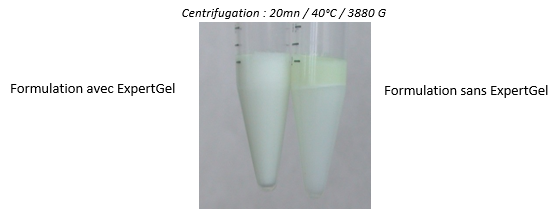
The ExpertGel® has already won two innovation awards in China and Germany for its unique properties.
For more information about those product, please contact us !
Sources :
https://fr.wikipedia.org/wiki/Ultraviolet
www.asef-asso.fr/production/la-creme-solaire-vous-veut-elle-du-bien-la-synthese-de-lasef/
https://fr.wikipedia.org/wiki/Rayonnement_solaire
https://fr.wikipedia.org/wiki/Cr%C3%A8me_solaire
www.revuepharma.fr/2017/06/statistiques-marche-produits-solaires/

